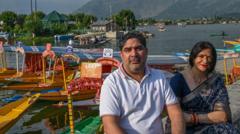Two months following a harrowing attack in Indian-administered Kashmir that almost escalated tensions between India and Pakistan, the stunning valley is starting to attract tourists once again. Shabana Awwal, vacationing at the iconic Dal Lake with her family from Rajasthan, highlights the need to experience Kashmir's beauty despite recent events.
Her family, a group of 15, had organized their trip initially in March to escape the oppressive Rajasthan summer during the children's school break. However, all plans altered drastically with the April attack near Pahalgam, where 26 tourists lost their lives. Kashmir's economy, heavily dependent on tourism, felt immediate repercussions as local authorities shut down numerous attractions, resulting in mass cancellations from potential visitors.
Chief Minister Omar Abdullah echoed this sentiment, stating that the ramifications of the attack reverberated throughout the region with "disaster" looming over the tourism season. Historically, despite longstanding conflict, tourists had seldom been targeted, making the incident particularly shocking.
Despite the dangers perceived by many, the Awwals, and other families like the Gandhis from Jammu, expressed their determination to continue their travel plans. They believe the situation has stabilized and attribute the apprehension primarily to exaggerated media portrayals of Kashmir's safety.
The arrival of Polish tourists has provided a glimmer of hope to local businesses reliant on travel for their sustenance. Haji Wali Mohammad Bhat, leader of the shikara owners' association, emphasized the dire need for tourism to restore their livelihoods, hinting that this "disaster" has affected everyone in the community.
Ravi Gosain, head of the Indian Association of Tour Operators, reported a significant leap in tourism before the attack and maintains optimism for a resurgence—local hospitality and ongoing efforts to welcome tourists could bring back visits. Notably, a new train service connecting Srinagar to the rest of India has sparked interest among pilgrims and tourists alike, with travelers like Ghanshyam Bharadwaj and family making spur-of-the-moment decisions to visit.
Abdullah remains hopeful that this initial inflow of visitors will lead to longer stays, enhancing the region’s economic recovery. With cautious optimism prevailing, Kashmir sets its gaze towards rebuilding its tourist reputation amidst the shadows of recent violence.


















